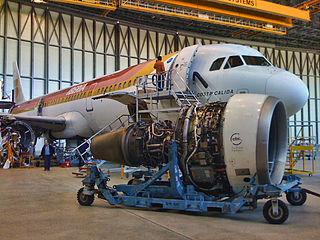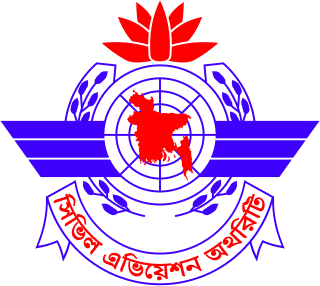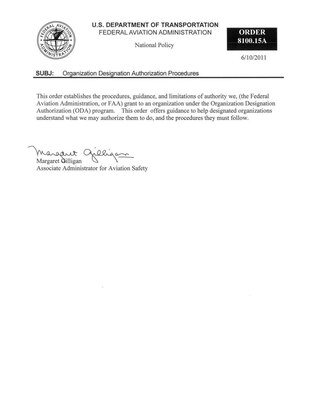
The Federal Aviation Administration (FAA) is the largest transportation agency of the U.S. government and regulates all aspects of civil aviation in the country as well as over surrounding international waters. Its powers include air traffic control, certification of personnel and aircraft, setting standards for airports, and protection of U.S. assets during the launch or re-entry of commercial space vehicles. Powers over neighboring international waters were delegated to the FAA by authority of the International Civil Aviation Organization.
The Federal Aviation Regulations (FARs) are rules prescribed by the Federal Aviation Administration (FAA) governing all aviation activities in the United States. The FARs comprise Title 14 of the Code of Federal Regulations (CFR). A wide variety of activities are regulated, such as aircraft design and maintenance, typical airline flights, pilot training activities, hot-air ballooning, lighter-than-air aircraft, man-made structure heights, obstruction lighting and marking, model rocket launches, commercial space operations, model aircraft operations, Unmanned Aircraft Systems (UAS) and kite flying. The rules are designed to promote safe aviation, protecting pilots, flight attendants, passengers and the general public from unnecessary risk.

ETOPS is an acronym for Extended-range Twin-engine Operations Performance Standards—a special part of flight rules for one-engine-inoperative flight conditions. The International Civil Aviation Organization (ICAO) coined the acronym for twin-engine aircraft operation in airspace further than one hour from a diversion airport at the one-engine-inoperative cruise speed, over water or remote lands, or on routes previously restricted to three- and four-engine aircraft.
Aeronautical Engineers Australia (AEA) is an Australian aeronautical engineering consultancy and aircraft technical service provider. It is the largest civil aircraft design organisation in the Asia Pacific region and is now headquartered in Adelaide.
A standard certificate of airworthiness is a permit for commercial passenger or cargo operation, issued for an aircraft by the civil aviation authority in the state/nation in which the aircraft is registered. For other aircraft such as crop-sprayers, a Special Airworthiness Certificate must be issued.
An Airworthiness Directive is a notification to owners and operators of certified aircraft that a known safety deficiency with a particular model of aircraft, engine, avionics or other system exists and must be corrected.

An electronic flight bag (EFB) is an electronic information management device that helps flight crews perform flight management tasks more easily and efficiently with less paper providing the reference material often found in the pilot's carry-on flight bag, including the flight-crew operating manual, navigational charts, etc. In addition, the EFB can host purpose-built software applications to automate other functions normally conducted by hand, such as take-off performance calculations. The EFB gets its name from the traditional pilot's flight bag, which is typically a heavy documents bag that pilots carry to the cockpit.
Parts Manufacturer Approval (PMA) is an approval granted by the United States Federal Aviation Administration (FAA) to a manufacturer of aircraft parts.

In aviation, airworthiness is the measure of an aircraft's suitability for safe flight. Initial airworthiness is demonstrated by a certificate of airworthiness issued by the civil aviation authority in the state in which the aircraft is registered, and continuing airworthiness is achieved by performing the required maintenance actions.

Aircraft maintenance is the performance of tasks required to ensure the continuing airworthiness of an aircraft or aircraft part, including overhaul, inspection, replacement, defect rectification, and the embodiment of modifications, compliance with airworthiness directives and repair.

Civil Aviation Authority of Bangladesh (CAAB) functions as the regulatory body for all aviation related activities in Bangladesh. It is the civil aviation authority operating under the Ministry of Civil Aviation & Tourism. All nine operational airports are operated by the CAAB. A member of International Civil Aviation Organization, it has signed bilateral air transport agreement with 52 states. It is headquartered in Kurmitola, Dhaka.

An air operator's certificate (AOC) is the approval granted by a civil aviation authority (CAA) to an aircraft operator to allow it to use aircraft for commercial purposes. This requires the operator to have personnel, assets, and system in place to ensure the safety of its employees, and the general public. The certificate will list the aircraft types, and registrations to be used, for what purpose and in what area – specific airports or geographic region.
An emergency Airworthiness Directive (EAD) is an airworthiness directive issued when an unsafe condition exists that requires immediate action by an aircraft owner or operator. An EAD is published by a responsible authority such as the FOCA, EASA or FAA related to airworthiness and maintenance of aircraft and aircraft parts. It contains measures which must be accomplished and the related periods to preserve their airworthiness. Technical information is addressed to operators and maintenance organisations of affected aircraft only. EADs become effective upon receipt of notification.
The Brazilian Organization for the Development of Aeronautical Certification is a nonprofit organization, of public interest, regulated by Brazilian Law number 9.790 as of March 23, 1999, and registered at the Brazilian Ministry of Justice on November 28, 2006.

In Canada an Aircraft maintenance engineer (AME) is a person who is responsible for signing the maintenance release of certified aircraft and is licensed to do so by the national airworthiness authority, Transport Canada (TC). Their job is to ensure that aircraft are maintained in a safe condition.
Continuing airworthiness management organisation (CAMO) is a civil aviation organization authorized to schedule and control continuing airworthiness activities on aircraft and their parts

The Boeing 737 MAX passenger airliner was grounded worldwide between March 2019 and December 2020 – longer in many jurisdictions – after 346 people died in two crashes: Lion Air Flight 610 on October 29, 2018 and Ethiopian Airlines Flight 302 on March 10, 2019. The U.S. Federal Aviation Administration (FAA) resisted grounding the aircraft until March 13, 2019, when it received evidence of accident similarities. By then, 51 other regulators had already grounded the plane, and by March 18, 2019, all 387 of the aircraft in service were grounded.

The Organization Designation Authorization (ODA) program was established by FAA Order 8100.15 . The ODA, in conjunction with the FAA, grants airworthiness designee authority to organizations or companies. The regulations addressing the ODA program are found in Title 14 of the Code of Federal Regulations part 183, subpart D, sections 183.41 through 813.67.

The Boeing 737 MAX was initially certified in 2017 by the U.S. Federal Aviation Administration (FAA) and the European Union Aviation Safety Agency (EASA). Global regulators grounded the plane in 2019 following fatal crashes of Lion Air Flight 610 and Ethiopian Airlines Flight 302. Both crashes were linked to the Maneuvering Characteristics Augmentation System (MCAS), a new automatic flight control feature. Investigations in both crashes determined that Boeing and the FAA favored cost-saving solutions, but ultimately produced a flawed design of the MCAS instead. The FAA's Organization Designation Authorization program, allowing manufacturers to act on its behalf, was also questioned for weakening its oversight of Boeing.

FAA Order 8110.37 , Designated Engineering Representative (DER) Handbook, is a handbook of procedures, technical guidelines, limitations of authority, and tools and resources for Designated Engineering Representatives (DERs) appointed by the Federal Aviation Administration. The handbook's purpose is to give both DERs and the FAA offices managing them a better understanding of their individual and mutual roles and responsibilities in the certifications of safety of aircraft and aviation systems. Although intended for the roles of DERs, this order may be useful to ODA engineering Unit Members, who are effectively DERs managed by aviation manufacturers rather than by the FAA.














